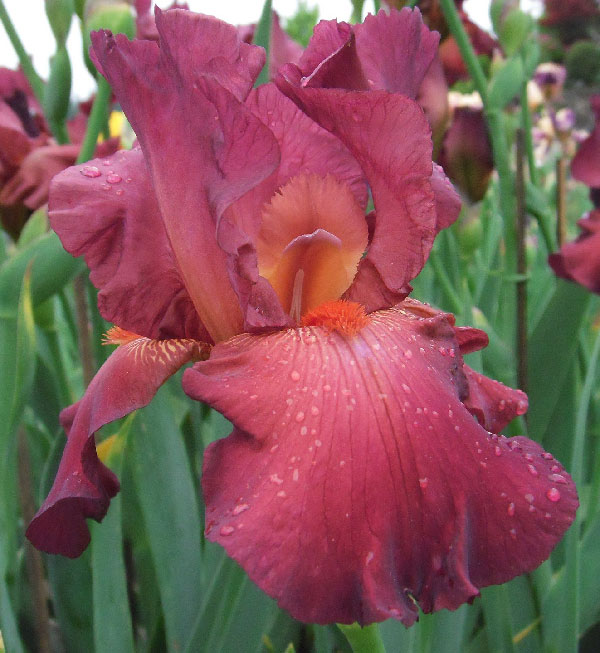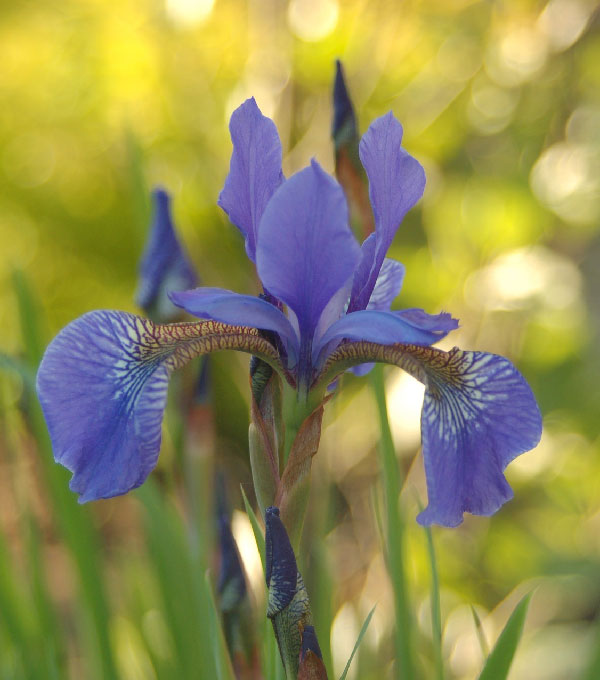Iris is a very popular and beautiful garden flower, providing great color in our gardens. Bearded, Japanese, Siberian, Spuria and yellow flag iris are all suitable for Nebraska. With the wide range in plant type, size, and adaptation, there is an iris for almost any location. By using an assortment of these types in a variety of sizes, iris bloom time can extend from early April through June. Plus, iris are vigorous plants and easy to grow even for the beginning gardener.
Now is the time to begin dividing bearded iris, but before you begin keep these tips in mind.
Growing Bearded & Siberian Iris
Bearded iris prefer a sunny planting location with good air circulation and well-drained soil. Sandy loam soil is best, but other soil types can be amended with compost or organic matter to improve soil quality. One possibility for areas with very poor soil is to create raised beds, making soil improvement easier and improving drainage.
Siberian iris thrive under a wide range of soil conditions, including damp or wet soil, but still prefer full sun for best flower development.
Whether plants are grown in a raised bed or not, loosen the soil to a depth of at least 10 inches before planting to make root establishment easier. Keep established plantings growing vigorously by fertilizing in spring, or after blooming, with 1 pound of 5-10-5 fertilizer per 100 square feet.
Watch Out for Iris Borer
Iris borer is the most serious insect pest of iris and is found virtually everywhere in the state. Look for dark colored lesions or streaks, or watery areas and ragged edges on developing leaves in May and June, and extensive destruction of the insides of the rhizomes in July and early August.
Insects overwinter as eggs and hatch during April and May. Young larvae feed on rapidly growing iris leaves, causing ragged notches on leaf edges, then begin tunneling through the leaves. At maturity, in late July or early August, the white to pinkish caterpillars are 1.5 to 2 inches long. Adult moths emerge in September and October from the soil, mate, and deposit eggs on dead leaves, particularly those that are dried and crinkled.
At this time of year, half-grown larvae can be found tunneling through the base of leaves or through iris rhizomes. They are usually accompanied by a foul-smelling soft rot. Keep an eye out for this as you begin to divide your iris.
Next spring, remove all old dead iris foliage before April 1. Sanitation reduces the problem by destroying overwinter eggs on these dead leaves.
 Bearded iris
Bearded irisDividing & Transplanting Bearded Iris
Mid-July to early-September is the best time for dividing and transplanting bearded iris. This ensures adequate root growth and establishment before winter. Bearded iris grow from an enlarged underground stem called a rhizome. All that is required is a few inches of firm, healthy rhizome with well-developed roots and at least one fan of leaves to start a new plant. Dividing and transplanting too-thick iris beds every three or four years is an important maintenance practice that ensures plants have adequate room to grow, and minimizes the effects of iris borer.
Before dividing, cut the leaves to about one third of their full height. Dig up the entire clump of rhizomes and brush away the soil. This will make it easier to decide where to divide the rhizome and which, if any, parts need to be discarded. Trim away and discard old sections of rhizome that don't have leaves and those that are rotting or brown inside. Watch for iris borer larvae and remove any you find.
Divide the remaining healthy rhizome sections so that each portion has at least one fan of leaves. Small sections with only one fan of leaves will not need dividing again for three to five years but will also be slower to produce a good show of flowers. Larger sections with two fans of leaves will produce flowers more rapidly but will also require division sooner.
Space divisions 8 to 10 inches apart in the new location. Create groupings with the fans all arranged, or pointed, in the same direction to prevent plants from growing into each other in years to come.
In light sandy loam soil, plant iris rhizomes just below the soil surface. In heavier soil, rhizomes should be planted so that the top edge is exposed slightly above the soil line to prevent rotting. Roots should be buried to provide good anchorage. Form a cone or ridge of soil in the bottom of each hole; place the rhizome on top of the cone and spread the roots around the outside of the cone then backfill with loose soil.
 Siberian iris
Siberian irisDividing Siberian Iris
Siberian iris grow from a crown with fibrous roots, in contrast to the thick rhizomes of bearded iris. Plants don't require frequent division, every 8-12 years is sufficient, but they respond well to early spring division when necessary. Dig up the plant's crown and divide the actively growing portions into good sized clumps. Discard the old sections of crown. Replant divisions at the same depth in the new location and keep them well watered for fastest root establishment.
Siberian iris can also be transplanted in fall but will need additional winter protection to prevent frost heaving if not given ample time to establish roots. In this case, apply a heavy winter mulch, 3-4 inches of wood chips, the first year to prevent plants from being pushed out of the ground.

